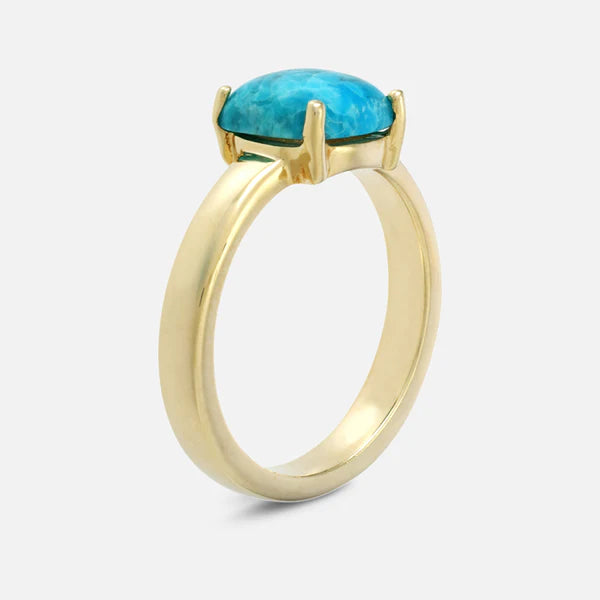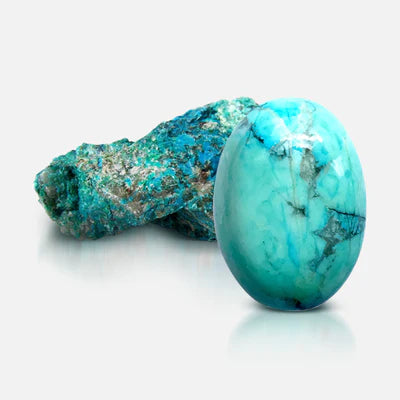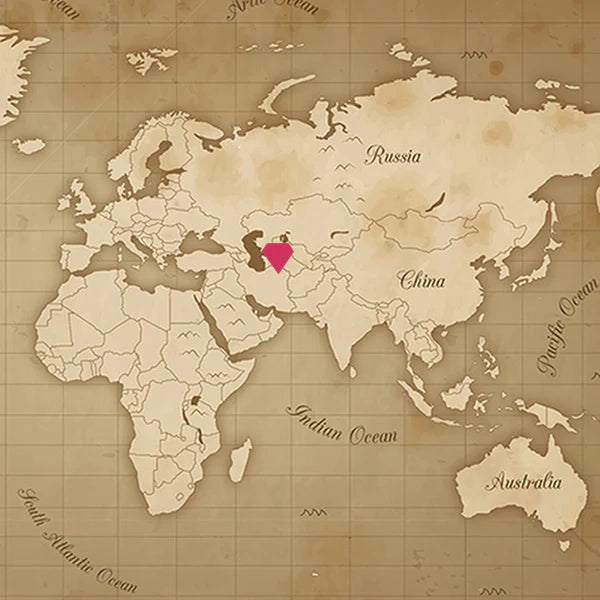Turquoise

FUN FACTS
In Ancient Persia, turquoise was worn in a necklace to ward off death; a change in color of the stone was believed to portend disaster
Turquoise is one of the most revered stones in Tibet, as it is believed to be a stone that brings good fortune, and is known as the ‘Sky Stone’
The stone is used extensively in jewelry by a number of Native American tribes including the Navajo and Apache for healing and protection
The Aztecs so revered turquoise that only their gods could wear it; ordinary people donning the stone could be punished with death
SELECTION OF JEWELRY
-
6 1/8 cts Turquoise and Tanzanite Earrings in 14K Yellow Gold by Carlo Viani
Regular price $1,620.00Regular priceUnit price / per -
Le Vian Grand Sample Sale Earrings featuring Robins Egg Blue Turquoise, White Sapphire, Blueberry Tanzanite set in 14K White Gold
Regular price $2,060.00Regular priceUnit price / per -
Le Vian Grand Sample Sale Ring featuring Robins Egg Blue Turquoise, Yellow Sapphire set in 14K Yellow Gold
Regular price $2,120.00Regular priceUnit price / per -
Le Vian Earrings featuring Robins Egg Blue Turquoise Blackberry Diamonds , Vanilla Diamonds set in 14K Vanilla Gold
Regular price $2,000.00Regular priceUnit price / per -
Carlo Viani Pendant featuring Robins Egg Blue Turquoise, Chocolate Quartz set in 14K Honey Gold
Regular price $1,340.00Regular priceUnit price / per -
10 1/8 cts Turquoise Ring in 14K Yellow Gold by Le Vian
Regular price $2,000.00Regular priceUnit price / per -
10 cts Turquoise Turquoise Cocktail Ring in 14K Yellow Gold by Le Vian
Regular price $2,780.00Regular priceUnit price / per -
2 1/3 cts Turquoise Turquoise Pendant Necklace in 14K Rose Gold by Le Vian
Regular price $2,240.00Regular priceUnit price / per -
10 1/8 cts Turquoise and Diamond Ring in 14K Yellow Gold by Carlo Viani
Regular price $1,690.00Regular priceUnit price / per -
7 1/2 cts Blue Turquoise Ring in 14K Yellow Gold by Carlo Viani
Regular price $1,770.00Regular priceUnit price / per -
Le Vian Grand Sample Sale Ring featuring Robins Egg Blue Turquoise, White Sapphire, Chocolate Quartz set in 14K White Gold
Regular price $1,340.00Regular priceUnit price / per -
10 1/8 cts Turquoise and Diamond Ring in 14K Yellow Gold by Carlo Viani
Regular price $1,690.00Regular priceUnit price / per -
"Liz" Mini Snakeskin Cross Body - Turquoise Snakeskin with Chocolate Quartz
Regular price $1,540.00Regular priceUnit price / per -
1 3/8 cts Blue Turquoise Pendant in 14K Yellow Gold by Carlo Viani
Regular price $1,130.00Regular priceUnit price / per -
8 3/8 cts Blue Turquoise Earrings in 14K White Gold by Carlo Viani
Regular price $1,780.00Regular priceUnit price / per -
12 1/2 cts Turquoise and Diamond Ring in 14K Yellow Gold by Le Vian
Regular price $2,460.00Regular priceUnit price / per -
11 cts Turquoise and Topaz Earrings in 14K White Gold by Carlo Viani
Regular price $2,810.00Regular priceUnit price / per -
10 1/4 cts Turquoise Turquoise Earrings in 14K Gold by Carlo Viani
Regular price $1,430.00Regular priceUnit price / per
Find Amazing Jewelry With Turquoise

Turquoise
ABOUT
Turquoise is thought to be one of the earliest gems to be cultivated, dating back nearly six thousand years to the Sinai Peninsula in Egypt. Native Americans are believed to have used the stone as far back as prehistoric times, and the stone became an extremely sought-after gift for Aztec rulers in the 12th and 13th centuries, right around the same time it began being used in China. Nonetheless, the stone’s name is simply French for ‘Turkish’ as it made its way via Turkey, and before that, Iran, where it was used in the construction of many religious buildings. It can be found all over the world, from the American Southwest where it is still prized by Native American artists, to Tibet, and the Middle East. The mineral is formed when water containing copper and aluminum leak through a rock, forming veins and then clumps of turquoise.

Turquoise
STORY
Turquoise is the third strongest gemstone after diamond and sapphire, celebrated not only for its beauty but also for its rich cultural significance. Its striking blue hue captures the essence of serenity, healing, and protection, symbolizing the deep connections people have with nature and spirituality.
Adored by ancient civilizations, turquoise has adorned royal crowns and ceremonial artifacts throughout history, revered by cultures from the Egyptians to Native Americans. It was believed to bring good fortune and shield its wearers from harm, making it a prized possession among kings and shamans.
Today, turquoise is cherished as a symbol of friendship and tranquility, often featured in jewelry gifts for loved ones. Celebrities frequently flaunt turquoise in stunning necklaces and statement pieces, and anyone wearing a beautiful turquoise pendant or bracelet is sure to feel a sense of connection and style.
GEMOLOGICAL SPECIFICATIONS
-
FAMILY
Phosphate Minerals
-
CHEMISTRY
CuAl6(PO4)4(OH)·4H2O
-
REFRACTIVE INDEX
1.610 - 1.650
-
BIREFRINGENCE
0.040
-
SPECIFIC GRAVITY
2.31 - 2.84
-
HARDNESS
5 - 6



















